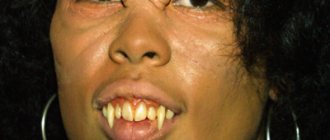- Types of neurotic disorders
- Signs of neurotic disorders
- Psychotherapy for neurotic disorders
What is a neurotic disorder
What is a neurotic disorder? It is a heterogeneous group of dysfunctions that arise as a result of acute or chronic psychological trauma. Symptoms are varied, but maladaptation, phobias, asthenia, obsessions and somatovegetative disturbances are always noted. A person's physical and mental abilities are temporarily weakened. Self-awareness and criticism persist. The diagnosis is made based on complaints, medical history and the person’s life history. To eliminate the problem, they resort to psychotherapy and medication.
Neurotic disorder is characterized
Doctors mean by neuroses a group of pathologies that arise due to the influence of mental trauma. A neurotic disorder is characterized by a deterioration in well-being, mood swings are noted, and somato-vegetative symptoms appear. In severe cases, suicidal thoughts are possible.
Causes of neurotic disorders
Doctors have different opinions regarding the catalyst for neuroses. Some believe that this condition develops due to a genetic predisposition, others – childhood psychological trauma. Children's psyche is weak, their memory is tenacious, any serious stress persists for a long time. Most of the complexes that a person suffers from in adulthood arose in childhood. Women are more susceptible to the disease.
Other causes of neurotic disorders:
- unfavorable environment, poor living conditions;
- prolonged physical overload in combination with stress;
- exhaustion of the nervous system;
- too busy work schedule;
- lack of proper rest;
- alcohol and drug abuse.
Neurotic dysfunctions occur when the body is exhausted.
Classification of neurotic disorders
Disorders are divided into 3 groups:
- hysterical;
- obsessive states;
- asthenic.
This classification of neurotic disorders is not similar to practice. It does not contain approved certain and most common pathologies. The differences lead to different ways of systematizing disorders.
Types of neurotic disorders
When making a diagnosis, doctors take into account the following types of neurotic disorders.
- Anxious-phobic. The main symptom is a sharp increase in anxiety and the appearance of obsessive fears. This group includes panic attacks, simple and complex phobias, and generalized anxiety disorder.
- Obsessive-compulsive. The main symptom is the appearance of obsessive ideas and actions.
- Asthenic disorders are characterized by asthenic syndrome.
- Somatoform. Clinically, they are similar to somatic ones, but do not imply a physical basis.
- Dissociative disorders imply disorders of motor function and sensations. Previously, this disease was classified as hysterical neuroses.
The sooner the patient seeks help, the more favorable the prognosis.
Forms of neurotic disorders
There are such forms of neurotic disorders.
- The most common is neurasthenia; it is divided into 3 stages. The first phase is characterized by irritability. Mental and physical abilities are not affected. The second stage is characterized by a decrease in working capacity, a person understands this. The third phase is manifested by lethargy, reluctance to do anything, and asthenic syndrome.
- Hysterical neurosis is the second form. The disease is caused by inappropriate behavior; the person is unpredictable and extremely irritable. There are signs such as seizures, paresis, vomiting, hypotension. The patient also complains of obsessive thoughts, a “lump” in the throat, and insomnia. During an attack, a person screams, lies on the floor, can get into a fight, or injure himself.
- The third form is depressive neurosis. It is characterized by symptoms such as insomnia, bad mood, loss of the ability to feel joyful emotions, a feeling of burden, and tearfulness. There are also disturbances in heart rhythm, stomach function, slow reaction to events, sexual dysfunction, and hypotension. The patient complains of despondency, sadness appears, and a feeling of uselessness.
- Obsessive states. With it, the patient is unable to control his thoughts and actions.
- Hypochondriacal neurosis - there is a fear of a circumstance from which a person cannot find a way out, or a fear of falling ill with an incurable pathology. The condition is complemented by hysteria and obsessions.
Each form requires an individual approach to therapy.
Neurotic disorders in adults
Neurotic disorders in adults have a reversible, relatively mild course, unlike psychoses. According to statistics, the problem is detected in 20% of the population. The causes include a disorder of brain activity responsible for human adaptation. Somatic and mental disturbances appear. Patients are rarely admitted to the hospital; conservative methods are usually successful.
Neurotic disorders in children
In children, the catalyst for the development of neurosis is delays in personality development. Against the background of separation from parents, stress, loss of a loved one, psychological trauma is possible. A child who experiences these situations becomes infantile or acquires neurosis.
Neurotic disorders in children: features of occurrence and course.
1. The age of 7-11 years is considered the affective stage of personality formation. If at this time the child encounters a traumatic factor, his development as a person may be delayed. In adulthood, such people experience emotional instability; a person cannot adequately assess the situation or think about the consequences. The only and beloved children acquire hysterical traits.
2. At the age of 11-14, a teenager learns to independently assess the situation, analyze, and plan his actions. There is a subsequent development of the affective component of the personality. If at this age a stressful situation arises, neuroses are possible in the future. Such teenagers outwardly look older than their peers and are more reasonable, but subconsciously, the synchronicity of personality development is disrupted.
Attention! The most important role in the successful growth of a child is played by the relationship with parents. Those who felt overprotected in childhood and were not allowed to make their own decisions become timid and unsure of themselves. It is in this category of people that neurotic disorders arise.
Astheno-neurotic syndrome
Astheno-neurotic syndrome is manifested by chronic fatigue, apathy, increased fatigue and irritability. This disease is complemented by loss of appetite and insomnia. Physical signs are associated with apparent heart disease. It may seem to a person that he has a slow heartbeat, or vice versa – tachycardia. No changes are observed on the cardiogram. However, the patient feels pain in the heart muscle. Stomach problems and migraines are also possible. Diagnostics involves interviewing and examining a person. An examination is being carried out for a viral infection. The prognosis is favorable, especially if the person additionally attends art therapy sessions. Drawing has a relaxing effect on the psyche, negative thoughts dissipate, and the patient feels harmony.
Consequences of emotional burnout
Ignoring burnout can have serious consequences. They can be like this:
- Chronic fatigue;
- Insomnia;
- Alcohol or substance abuse;
- Heart disease;
- High blood pressure;
- Diabetes mellitus type 2;
- Vulnerability to disease.
Therefore, it is so important to diagnose this syndrome in time and try to correct it as soon as possible.
“Emotional burnout can lead to quite serious consequences. It's not just weight changes or sleep disturbances. A whole cascade of pathological reactions in the body is launched.
The menstrual cycle is disrupted, ovulation disappears, which can lead to infertility, PMS develops, and many develop benign tumor-like diseases - fibroids, cysts, mastopathy, endometriosis. Some women begin to bleed, while others may miss their periods. Memory and concentration decrease significantly, it becomes difficult to work, study, and absorb new information. The nervous system cannot adapt to what is happening and fails. For some, this can result in neurosis or aggression, for others - in depression. Depletion of the entire endocrine and immune system leads to the development of a variety of diseases against this background - from systemic to oncological. And it is very important to stop this process in time.”
Lyudmila Vladimirovna Mudragel
obstetrician-gynecologist, gynecologist-endocrinologist, ultrasound diagnostics doctor, specialist in aesthetic gynecology, doctor of integrative and anti-aging therapy
Experience: 23 years
Dysthymia – depressive neurotic disorder
The disease is characterized by a depressed state in the patient, which does not go away for more than 2 years. The pathology is characterized by decreased vital energy and increased fatigue. A person feels apathy and is unable to enjoy life. Self-esteem decreases and self-confidence is lost. Such people rarely share their emotions with others. The most severe consequence is suicide. The patient is referred to a psychotherapist. With timely treatment, dysthymia, or depressive neurotic disorder, is treatable.
How does depression develop in stages?
At first, the patient experiences a depressed state, which he himself attributes to fatigue, a hard work week, drinking alcohol and other reasons. At the same time, he wants to retire from others and at the same time is afraid of being left alone.
Then the stage of acceptance occurs: awareness of a dangerous condition occurs, the problem gets worse, the intensity of negative thoughts increases, the body and immune system malfunction.
The third stage - in the absence of adequate therapy, the patient loses control over himself, aggression increases.
Symptoms of neurotic disorders
Neurotic dysfunctions are characterized by instability of mood and rash actions. Patients suffer from memory impairment, problems with concentration, and a number of other clinical manifestations:
- causeless psychological stress;
- increased fatigue;
- sleep problems;
- isolation;
- fixation on problems in life;
- memory impairment;
- dizziness;
- fainting;
- migraine;
- pain in the heart muscle and joints;
- frequent urination;
- excessive sweating;
- decreased potency;
- high or low self-esteem;
- inconsistency, uncertainty;
- tearfulness;
- aggressiveness;
- suspiciousness;
- poor prioritization.
Symptoms of neurotic disorders are often complemented by increased sensitivity to light, sound, and reactions to minor temperature changes.
Signs of neurotic disorders
Signs of neurotic disorders vary by gender. In women, asthenic neurosis more often appears, characterized by aggressiveness, loss of mental and physical ability, and lack of sexual desire. During intimacy, it is impossible to relax. A woman suffering from asthenic neurosis quarrels with relatives and often loses her temper over trifles. Constant tension is fraught with the development of diseases of internal organs.
In men there are the following types:
- depressed – a person is not able to realize himself in the world of work, or adapt to sudden changes in any area of life;
- male neurasthenia - usually appears after physical or moral overstrain; workaholics are susceptible to this type.
Men and women over 45 years of age are prone to these types of diseases. They may still have problems with the functioning of their internal organs.
Neurotic disorder syndrome
The syndrome of neurotic disorders is a reflection of a traumatic circumstance and is often combined with other neurotic manifestations. The patient's mood decreases, but there is no feeling of melancholy. Usually, a bad mood is combined with emotional lability, asthenia, mild anxiety, loss of appetite and insomnia. During the day, no special fluctuations are observed, or they are mild. Mental and motor retardation, self-flagellation, and suicidal thoughts are not typical.
- Neurotic depression is distinguished from reactive depression, which is also caused by traumatic circumstances. In the second type, the symptoms reach the level of reactive psychosis - the patient is depressed, inhibited, consciousness is narrowed, and thoughts of suicide appear.
- In the case of psychotic depression, the patient wishes to die, there is gross disorientation of the personality with separation from life, sudden anosognosia, delusional ideas of self-humiliation, manic episodes. The condition can be controlled with antidepressants and a repeated course of treatment.
- Neurotic depression is characterized by the preservation of the basic personality qualities, the patient is aware of his condition. Obsessive phobias and pronounced hysterical manifestations appear.
Important! Psychotic depression is more dangerous for a person and requires immediate treatment.
Levels of neurotic disorders
Neurotic disorders occur at 3 levels: as a manifestation of individual symptoms, at the level of minor syndromes, and as specific disorders.
Levels of neurotic disorders.
- Individual symptoms. They are also present in those who do not suffer from mental disorders.
- A minor emotional disorder can be complemented by several neurotic syndromes, of which the leading one is not identified.
The patient population consists of 2 types:
- some suffer from an acute, short-term stress reaction;
- others experience long-term, chronic impairment.
Most patients recover within six months, while others recover in no less than 3 years.
Hyposthenic form
It can develop as the next phase of asthenic neurosis or occur immediately in people with an asthenic psychotype. At this stage, a patient with neurasthenia suffers from mental and physical weakness, lethargy, low mood, lack of interest in any activity, and passivity. Feelings of sadness and anxiety haunt him constantly, causing emotional instability. A neurasthenic person is prone to tearfulness, touchiness, and complaints about his health. Being focused on his sensations, he cannot concentrate to perform intellectual tasks or physical work. Asthenic neurosis can be either an independent disease or a harbinger or manifestation of more serious, difficult to treat mental disorders - schizophrenia, atypical depression. Neurasthenia can also be a symptom of somatic diseases - HIV, tuberculosis, oncology, etc. Therefore, it is so important to consult a specialist in time when the first signs of the disease appear. An experienced psychiatrist or psychotherapist at the Neopsy Mental Health Center is able to differentiate this disorder from other diseases and prescribe effective treatment with a lasting positive therapeutic result.
Diagnosis and treatment of neurotic disorders
A person should contact a psychologist or psychotherapist. Diagnostics requires an integrated approach.
The color technique is widely used.
- All shades take part in it. Neurosis-like syndrome is noted when a person selects or repeats gray, purple, brown or black.
- With hysterical neurosis, the patient chooses 2 colors - purple and red. This also indicates low self-esteem.
To determine the symptoms, a test is carried out - it makes it possible to identify the presence of chronic fatigue, anxiety, and self-doubt. Diagnosis and treatment of neurotic disorders are closely interrelated.
Drug therapy is used in the first stages to relieve internal tension and eliminate insomnia. Antidepressants and tranquilizers are widely prescribed. Depending on the severity and duration of the clinical picture, the doctor prescribes drugs from different groups to the patient:
- non-selective – Amitriptyline, Imipramine;
- selective influence - Maprotiline, Fluoxetine;
- sedative antidepressants – Doxelin, Azafen;
- balanced – Sertalin, Tryptophan;
- stimulants - Heptral, Bupropion.
Obsessive states are well relieved by drugs from the SIDS group - Prozac, Paroxetine, Escitalopram. Frequently prescribed tranquilizers include Phenazepam, Tofisopam, Meprobamate. All medications are prescribed in a short course of 5-7 days, sometimes extended to 10.
Important! If a person self-prescribes medications, the disease may transform and the condition may worsen.
Psychotherapy for neurotic disorders
To achieve maximum effect, doctors recommend supplementing drug treatment with rational, cognitive psychotherapy. The main objective of this technique is to eliminate the consequences of a stressful situation so that the general condition of a person improves and the symptoms of neurosis are eliminated. The doctor discusses the cause of the problem and works through the traumatic circumstances. The patient learns relaxation techniques, the ability to level out negative emotions and complexes. The most difficult thing to eliminate is negative attitudes given by parents. A person must show his will, diligence, and do his homework. Typically, psychotherapy for neurotic disorders consists of 7-15 sessions, depending on the degree of complexity of the problem. In severe cases, the patient is admitted to the department of borderline mental disorders.
Recovery stages
Having diagnosed the signs of emotional burnout and made attempts to get rid of it, a person has already made a huge effort on himself. After all, the rehabilitation path is the hardest – always at the beginning. The more effective the techniques for overcoming a stressful situation are, the more often they are used in practice, the faster a person will notice qualitative changes in himself:
- Specific life goals
- Awareness of the presence of external traumatic factors, development of a plan to overcome them
- The desire to spend time with loved ones and do something new
- Predominance of positive thoughts.
This is the only positive feature of emotional burnout. If a person successfully copes with the syndrome, his life changes forever for the better.
Prevention
It is possible to prevent the development of neurotic disorders by leading a healthy lifestyle. It is important to sleep 7-8 hours a day, go to bed before 1.00, resolve internal conflicts in a timely manner, and avoid stress. If a person’s work involves difficult situations or psychological overload, it is worth thinking about changing the sphere of work.
Prevention of neuroses: effective tips.
- Do not abuse alcohol or smoking. Intoxication provokes a deterioration in adaptive capabilities, and various diseases appear. When drinking alcohol regularly, the psyche suffers and a severe hangover occurs.
- The food menu should always include a lot of vegetables, fruits, lean meats and fish. It is advisable to rely on dairy products and take a course of vitamins in the off-season. Overeating is also dangerous; you need to consume food in moderation.
- Music. This is an effective prevention method that involves listening to calm melodies. This could be the sound of rain or sea, falling snow and other natural phenomena. You should listen to soothing music before bed, or after a stressful situation. It can be found on YouTube, social networks, it is advisable to record it on a smartphone so that you can always relax.
- It is important to exercise in moderation. Physical activity is the key to mental health. It is advisable to do exercises every morning or evening, you can join a gym, go to the pool 2-3 times a week.
- Plan your actions, act according to the plan. Then there will be fewer stressful situations if a person does not let everything take its course.
- Treat all diseases in a timely manner. Regular pain causes emotional stress.
- It should be remembered that family conflicts, especially constant ones, cause serious stress. Family is the rear, not the battlefield. If there are problems in your personal life and they are not resolved, it is better to change your partner.
If it was not possible to prevent neurosis, you need to seek help in a timely manner. Then the chances of leveling out the negative psychological state are maximum.
What happens if a neurotic disorder is not treated?
Neuroses can cause complications if left untreated. Many people ignore therapy and do not go to doctors. Post-Soviet stereotypes that going to a psychotherapist is shameful still live in people’s heads. Such negligence entails irreversible changes in the psyche.
What happens if a neurotic disorder is not treated:
- increased symptoms;
- the patient becomes hysterical and hypersusceptible;
- self-esteem suffers;
- other chronic diseases appear;
- the risk of catching a cold increases;
- the formation of an explosive personality that does not tolerate returns, is aggressive, and concentrates only on the negative.
A person becomes a hypochondriac, his personality is destroyed. The last stage is caused by complete apathy, the person does not get out of bed, and may refuse food. The patient is no longer able to do without medications or control his emotions. High risk of suicide. It is extremely difficult to treat this condition; it can lead to more serious mental pathologies. You cannot do without long-term psychotherapy, taking medications and staying in a neurosis clinic.
Irritable weakness
This is the next phase of the disease if adequate treatment was not carried out in the first. From the name it is clear that the stage is characterized by increased irritability against the background of increasing mental exhaustion. Easily excited for any reason, the patient, after a short-term, bright burst of temper, feels powerless. The state of excitement is easily replaced by a feeling of resentment and crying. Concentration and concentration are difficult, causing fatigue, headaches and other painful sensations of various localizations. Repeated distractions from the work process with the desire to take a break do not relieve fatigue, and returning to work does not bring the expected results, which leads the neurasthenic to severe mental exhaustion.










